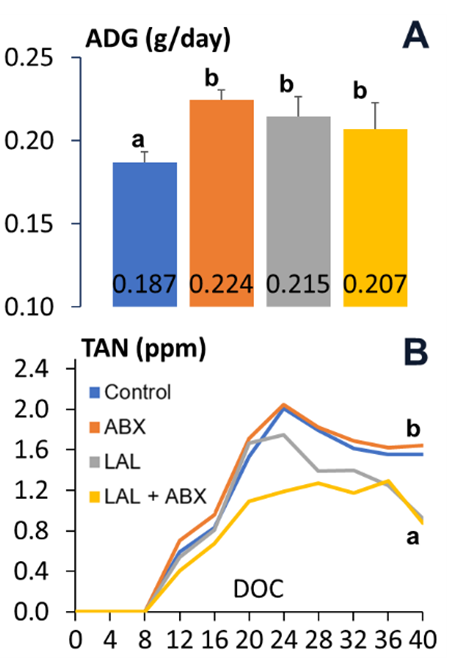News | Reading Time 2 minutes
In-feed Probiotics and Water Bioremediation Significantly Enhance Shrimp Performance and Robustness
Lallemand to present new study on water and gut microbiota modulation in shrimp at APA 2024
A 42-day trial in Vietnam using whiteleg shrimp juveniles confirms the efficacy of microbiota modulation strategies and their potential to improve shrimp growth performance and robustness during growth stage, according to a new research we presented at the Asian Pacific Aquaculture (APA) conference in Indonesia earlier this month.
Combined approach using probiotics and water bioremediation strategy
The research titled “In-feed Probiotics and Water Bioremediation Improved Growth, Biomass, Survival, Water Chemistry and Microbiota in Whiteleg Shrimp Litopenaeus vannamei in Vietnam,” presented by Ana Rodiles, research scientist at Lallemand Animal Nutrition focuses on the shrimp grow-out period and reveals that the use of specific bioremediation bacteria in water and in-feed probiotics represent an efficient solution in the context of reducing the use of antibiotics to support shrimp performance and shrimp resilience to an abiotic stress.
A previous study led by Rodiles demonstrated the benefits of a combined approach using a selected mix of beneficial microbial solutions in feed and bioremediation bacteria in rearing water during shrimp hatchery and nursery phases, according to Lallemand Internal Research (2020).
Trial design and results
The 42-day grow-out trial was performed in Vietnam using whiteleg shrimp juveniles reared at high density in outdoor tanks with low water exchange under commercial-like conditions. Four treatments were applied: a control group, an antibiotic group (ABX), a Lallemand group (LAL - LALPACK Probio and LALPACK Immune supplementation in the feed and LALSEA Biorem in pond water), and a combined antibiotic+Lallemand group (LAL+ABX).
An abrupt exposure to fresh water simulated the stress to test the shrimps’ resilience to abiotic challenges. Classical microbiology analysis was conducted to examine shrimp gut and water microbiota counts. In addition, rearing water was sampled for microbial community analysis through 16S rRNA sequencing. Water biochemistry parameters were also assessed during the trial.
The results showed significant improvements in biomass gain and average daily growth in all supplemented groups compared to the control (Fig.1A). Resilience to abiotic stressors was higher in all supplemented groups, with the Lallemand group showing a 14% increase in time to 50% mortality, and the combined group showing a 29% increase.
Furthermore, ammonia and nitrite levels were lowest for both Lallemand groups (Fig.1B). Levels of lactic acid bacteria in water and gut were significantly higher in both Lallemand groups, indicating a healthier gut microbiota. The modulation on water microbial 16S communities of Lallemand groups contributed to mainly the increase in Candidatus Aquiluna (related to enhance carbon turnover and/or nutrient acquisition) and decreases in NS3a_marine group (associated to dinoflagellates blooms).
This study shows that choosing the right microbial solutions for shrimp feed and water can boost performance and promote sustainable shrimp farming practices. This research confirms that microbial-based solutions enhance shrimp resilience, gut health, and pond water quality, with measurable benefits demonstrated by sequencing technologies.
REFERENCES
Rodiles, A., Leclercq, E., Castex, M. 2024. In-feed probiotics and water bioremediation improved growth, biomass, survival, water chemistry and microbiota in whiteleg shrimp litopenaeus vannamei in vietnam. Asian-Pacific Aquaculture 2024. July 2-5, 2024. Subaraya, Indonesia
Published Jul 11, 2024 | Updated Jul 29, 2024
Related articles
Need specific information?
Talk to an expert